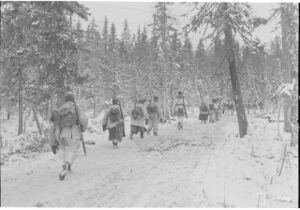Battle of Tortsy
The Battle of Tortsy was a battle during the Imperial Civil War and the deciding engagement of the Oktobrisk Campaign. Fought between Imperial and Leftist forces over a 14 day period, the battle ended in a Leftist victory as the Imperial forces were pushed back to the town of Oktobrisk where they were besieged until mid-January.
Background
Following the initial setbacks that proceeded the Leftist uprisings on Oktobrisk and coordinated mutiny amongst the Oktobrisk Naval Station, General Edward Doyle brought his command at the central settlement of Tortsy. Tortsy was a vital base on the road to the city of Oktobrisk itself. Under Doyle's command was the Imperial Oktobrisk Rifles, which consisted of six battalions, the Oktobrisk Mountain Brigade, a professional and well-equipped brigade of regular troops and the Thirteenth Infantry Brigade of the Germanan Army. Under the direct command of Ferdinand von Hallenberg, a Germanan-born officer in the Imperial Army, the 13th Infantry Brigade was well-trained and equipped but lacked supplies and morale was reportedly poor. Also under Doyle's command was around 16,000 loyalists, these were militiamen, civilian volunteers and surplus military forces including loyalist sailors from the Oktobrisk Naval Station and airmen from the captured Åndalden Airbase.
Jasper Lane, chairman of the Oktobrisk Trades Union Congress was quickly elected to command the Leftist forces on Oktobrisk, along with Matayev Ivanovich, a Socialist police commander from Álfröst. He pulled his forces together at Åndalden Airbase and, though he failed to make use of any of the remaining aircraft, his forces captured weeks of food supplies and fuel, along with a small number of weapons and ammunition. Leftist forces were organised into three 'Red Brigades' and two 'Worker's Columns', these purposely distinctive units were used in similar roles during the battle, whatever their stated differences.
Doyle correctly deduced that Ivanovich would march on Tortsy and use it as a staging base for an assault on the city of Oktobrisk. Thus, he entrenched his forces along a ridgeline south of the settlement and made preparations for a defensive engagement.
Battle
Initial Attacks
General Doyle's dug-in troops just about covered the ridgeline south of Tortsy, backed up with artillery and a small number of Germanan assault guns captured during the Second Europan War. The main line along the ridge consisted of trenches and wooden bunkers and pillboxes, garrisoned by his loyalist auxiliaries. In reserve he kept the Germanan 13th Brigade and the IOR. He placed the Oktobrisk Mountain Brigade on his right flank where a flanking manoeuvre was possible and backed them up with his few armoured vehicles.
Matayev Ivanovich, his forces devoid of heavy equipment, decided on using massed infantry attacks to break the Imperial line. He first committed the Worker's Columns as assault units. They moved through wooded areas to the direct south of Tortsy to avoid being spotted until the last possible moment. At 1pm on the 2nd of December, the battle begun. Worker's Column A moved swiftly out of the woods and attacked with a wide frontage against Doyle's centre, using rifles, shotguns and melee weapons. Doyle's entrenched loyalists, similarly armed to their Leftist opponents, threw back the attack with relative ease, pouring enfilade gunfire downhill at the massed lines of rebels.
As Column A made its futile attack against the entrenched Imperial centre, Worker's Column B stealthily moved to the left and, at 2pm, attacked Doyle's right flank. Expecting a clear path around Doyle's flank, Column B ran right into the guns of Ranya Yanovich's mountaineers.
Fighting on the flank
Column B was engaged from the front by the entrenched Oktobrisk Mountain Brigade who were supported with Germanan assault guns, captured during the Second Europan War. Michael Fetter, Column B's commander was killed by a marksman and his men were decimated by gunfire from the woods. The column fell back in disorder but was sent back by Jasper Lane three times over the next few days, sustaining overwhelming casualties in the process.
It soon became obvious that Lane was obsessed with completing a flanking manoeuvre. Attacks on the Imperial right flank took place every few hours, mainly by Worker's Column B and the 1st Red Brigade. The mountaineers stood their ground, even when their commander, Ranya Yanovich, was killed during the fighting. By the 7th of December, 80% of the fighting had been on that flank, the Imperials had sustained 1,000 casualties and the Leftists had taken 3,500, many of them dead. At around midday on the 7th, the assault guns ran out of ammunition, as did the mountain guns. This impacted the mountaineers direly and, after dogged fighting by advanced guard units, the whole brigade was pulled back to form a right angle with the main line.
Lane was now in a prime position. He had seized the wooded high ground occupied by the mountaineers and regrouped his forces, now depleted by the heavy fighting on the flank. General Doyle called a staff meeting and decided to begin the evacuation to Oktobrisk town on the tenth. Until then, he kept his men on high alert and bolstered the right flank with soldiers of Colonel von Hallenberg's 13th Infantry Brigade. There was no fighting on the ninth, Lane deciding to rest his men, consolidate his position and plan for the next assault.
Final Fighting
Aftermath
Order of Battle
Imperial
Imperial Oktobrisk Rifles
Oktobrisk Mountain Brigade
![]() 13th Infantry Brigade
13th Infantry Brigade
Oktobrisk Loyalist Militia
Leftist
1st Oktobrisk Red Brigade
2nd Oktobrisk Red Brigade
3rd Oktobrisk Red Brigade
Oktobrisk Worker's Column A
Oktobrisk Worker's Column B

